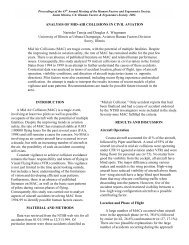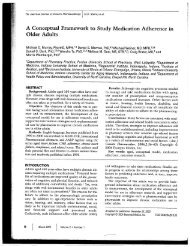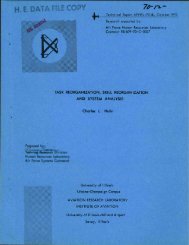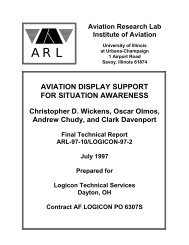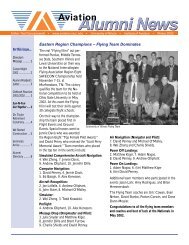Usability Questionnaire Results - Institute of Aviation - University of ...
Usability Questionnaire Results - Institute of Aviation - University of ...
Usability Questionnaire Results - Institute of Aviation - University of ...
Create successful ePaper yourself
Turn your PDF publications into a flip-book with our unique Google optimized e-Paper software.
differently by the use <strong>of</strong> color. Careful planning is necessary to optimally employ color in adisplay.2.3.1 Benefits <strong>of</strong> ColorChrist (1975) found strong benefits <strong>of</strong> color after reviewing much <strong>of</strong> the literature oncolor coding and performing a meta-analysis. One <strong>of</strong> the most overall apparent findings was thatif color <strong>of</strong> a target is unique and known in advance for that target, then it would aid the process<strong>of</strong> identification and searching. This means that color is quite beneficial for rapid localizationand Christ suggests that the effect <strong>of</strong> color is superior to that <strong>of</strong> size, shape or brightness <strong>of</strong>targets to be identified or searched for.A similar finding was revealed in work by Fisher and Tan (1989). Their work exploredthe use <strong>of</strong> color as a highlighting mechanism. The intent <strong>of</strong> highlighting is to attract attention toan area to aid in search and identification <strong>of</strong> targets. Fisher and Tan were able to showempirically that color was superior to boxing, blinking, and reverse video as a means <strong>of</strong>highlighting as long as the color is highlighting an important target.Another aspect <strong>of</strong> color that has been seen as a great benefit is that some colors tend tohave well established population stereotypes (Wickens & Hollands, 2000). Within a givenpopulation, colors have come to represent information and meanings. For example, westerncultures tend to recognize the color red as symbolizing warnings, danger, or stopping. The colorgreen is typically used to symbolize safety or to “go”. A person who uses a display for the firsttime would likely associate the color red or green to have one <strong>of</strong> these meanings without beingexplicitly told so. Road signs and stop lights capitalize on these color stereotypes to provideredundant information. Stop signs and stop lights use the color red. These population stereotypesprovide a type <strong>of</strong> guideline to use when implementing color in a display.As was seen earlier in the discussion about the proximity compatibility principle, colorwas one way to manipulate display proximity. Two or more display elements can be linkedtogether spatially by using a common color scheme. For example, Wickens and Andre (1990)found that identical colors for two objects in a display can create a display proximity effect thatbenefits tasks that require integration <strong>of</strong> information. This feature was included as a physicalmetric <strong>of</strong> display proximity, an alternative to the better known attribute <strong>of</strong> physical distancebetween display elements that is more commonly associated with the proximity compatibilityprinciple. If multiple bar graphs are included in a display but only two <strong>of</strong> them need to becompared to each other or integrated, portraying the two bar graphs in the same color wouldserve as a means to group them and integrate them without changing their position in space.Color has also been shown to provide a benefit in terms <strong>of</strong> redundant coding.Redundancy in this case refers to more information than is minimally needed to identify a targetis provided (Christ, 1975). Color can be used quite effectively as a redundant feature to shape.If in a display circles are always green, squares are always red, and triangles are always yellow,then color is serving as a redundant attribute. Color alone would be enough to give cues as towhether an object is a circle, square or triangle. It may be necessary to inform users on how theredundancy plays an effect so that they can take advantage <strong>of</strong> it. Backs and Walrath (1995)15






